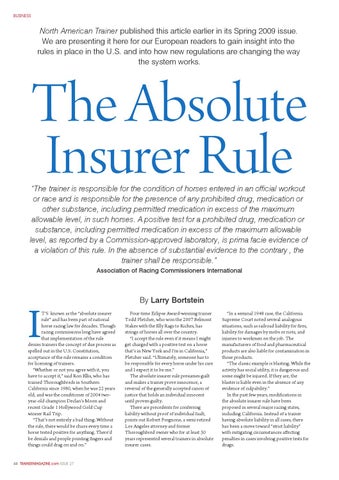Absolute Insurer issue 27.qxd:Jerkins feature.qxd
20/8/09
20:34
Page 1
BUSINESS
North American Trainer published this article earlier in its Spring 2009 issue. We are presenting it here for our European readers to gain insight into the rules in place in the U.S. and into how new regulations are changing the way the system works.
The Absolute Insurer Rule
“The trainer is responsible for the condition of horses entered in an official workout or race and is responsible for the presence of any prohibited drug, medication or other substance, including permitted medication in excess of the maximum allowable level, in such horses. A positive test for a prohibited drug, medication or substance, including permitted medication in excess of the maximum allowable level, as reported by a Commission-approved laboratory, is prima facie evidence of a violation of this rule. In the absence of substantial evidence to the contrary , the trainer shall be responsible.” Association of Racing Commissioners International
I
T’S known as the “absolute insurer rule” and has been part of national horse racing law for decades. Though racing commissions long have agreed that implementation of the rule denies trainers the concept of due process as spelled out in the U.S. Constitution, acceptance of the rule remains a condition for licensing of trainers. “Whether or not you agree with it, you have to accept it,” said Ron Ellis, who has trained Thoroughbreds in Southern California since 1980, when he was 22 years old, and was the conditioner of 2004 twoyear-old champion Declan’s Moon and recent Grade 1 Hollywood Gold Cup winner Rail Trip. “That’s not entirely a bad thing. Without the rule, there would be chaos every time a horse tested positive for anything. There’d be denials and people pointing fingers and things could drag on and on.”
44 TRAINERMAGAZINE.com ISSUE 27
By Larry Bortstein Four-time Eclipse Award-winning trainer Todd Pletcher, who won the 2007 Belmont Stakes with the filly Rags to Riches, has strings of horses all over the country. “I accept the rule even if it means I might get charged with a positive test on a horse that’s in New York and I’m in California,” Pletcher said. “Ultimately, someone has to be responsible for every horse under his care and I expect it to be me.” The absolute insurer rule presumes guilt and makes a trainer prove innocence, a reversal of the generally accepted canon of justice that holds an individual innocent until proven guilty. There are precedents for conferring liability without proof of individual fault, points out Robert Forgnone, a semi-retired Los Angeles attorney and former Thoroughbred owner who for at least 30 years represented several trainers in absolute insurer cases.
“In a seminal 1948 case, the California Supreme Court noted several analogous situations, such as railroad liability for fires, liability for damages by mobs or riots, and injuries to workmen on the job. The manufacturers of food and pharmaceutical products are also liable for contamination in those products. “The classic example is blasting. While the activity has social utility, it is dangerous and some might be injured. If they are, the blaster is liable even in the absence of any evidence of culpability.” In the past few years, modifications in the absolute insurer rule have been proposed in several major racing states, including California. Instead of a trainer having absolute liability in all cases, there has been a move toward “strict liability” with mitigating circumstances affecting penalties in cases involving positive tests for drugs.
